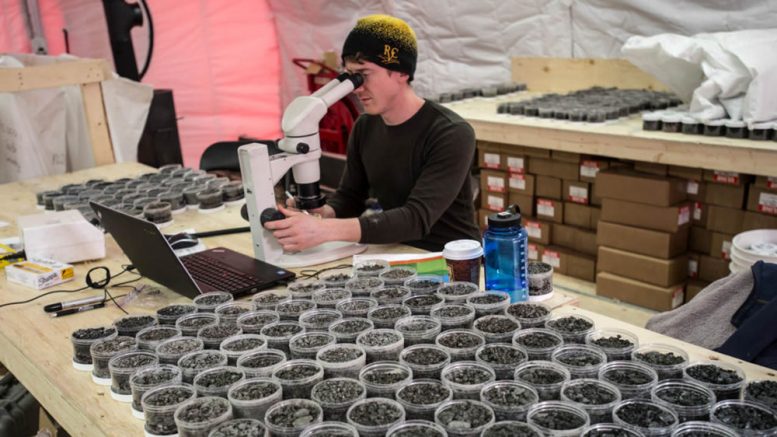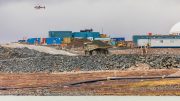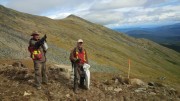In early April 2019, Mountain Province Diamonds (TSX: MPVD; NASDAQ; MPVD) updated the resource estimate for its Faraday 2 kimberlite — one of several kimberlites at its Kennady North diamond project in the Northwest Territories. This is the first update to the Faraday 2 kimberlite resource since 2017.
The Faraday 2 kimberlite now contains 2.07 million inferred tonnes grading 2.63 carats per tonne for 5.45 million carats. The updated resource shows a 49% increase in tonnage, 17% in grade and 74% in carats. The average value per carat has also increased 25% over the 2017 value, from US$112 per carat to US$140 per carat.
“It’s actually just an interpretation of the previous drill core that we’d had from that area,” Mountain Province Diamonds president and CEO Stuart Brown says in an interview with The Northern Miner. Brown joined Mountain Province in May 2018.
“We decided to get it tested for micro diamonds. We also then reran all the diamond price information and the distribution of the grade and interpreted that, which allowed us to give what we believe are far better results and more meaningful results for the whole orebody. So it increased the size of the orebody from a tonnage perspective, and it also increased the value dramatically.”

The 5034 pit at De Beers and Mountain Province Diamonds’ Gahcho Kue mine in the Northwest Territories. Credit: Mountain Province Diamonds.
The company had previously spun out its Kennady North assets into another company called Kennady Diamonds. They included the Faraday 1, 2 and 3 kimberlites, and the Kelvin kimberlite. Mountain Province reacquired the assets by buying Kennady Diamonds in early 2018.
Faraday 1 and 3 hold a combined 1.87 million inferred tonnes at 1.01 carats per tonne for 1.9 million carats. The Kelvin kimberlite has 8.5 million indicated tonnes at 1.6 carats per tonne for 13.62 million carats.
“It was part of our review to increase the value of Kelvin and Faraday as a whole with the least amount of money possible, which I think has worked very well for us,” Brown says.
The updated resource includes the northwest extension of Faraday 2 — which Kennady discovered in 2017 — and extended the kimberlite 150 metres. It includes more than 22,100 metres of core drilling across 102 holes, as well as more than 3,600 metres of large-diametre drilling across 31 reverse-circulation holes.
Faraday 2 is shaped irregularly, with an inclined, pipe-like body. It has been drill defined over 600 metres and remains open to the northwest. The body varies in width between 30 and 50 metres, and the vertical thickness ranges from 10 to 100 metres beneath the southeast end of Faraday Lake, and 59 metres thick at the furthest end of the northwest extension.
The Faraday 1, 2 and 3 kimberlites and the Kelvin kimberlite are located 10 km northeast of the Gahcho Kué diamond mine, on adjacent exploration properties wholly owned by Mountain Province. Mountain Province is a 49% joint venture owner with De Beers at Gahcho Kué. Four kimberlites are being developed at Gahcho Kué under the current mine plan. Mountain Province controls 671 sq. km around Gahcho Kué.
“With this small piece of work, we now have a meaningful set of orebodies that should be able to be integrated into the overall mine plan, once we’ve locked down the next mine-planning phase,” Brown says.
“We want to avoid having to build a stand-alone plant — I don’t think the orebody would be as profitable if we did that. I’d prefer to bring it into the joint venture at an appropriate time.”
Gahcho Kué produced 6.93 million carats in 2018 — up from 5.93 million carats the year before. It generated $311 million in sales revenue in 2018, which is up from $170 million the year before. In 2018’s fourth quarter, it treated 751,000 tonnes at 2.06 carats per tonne to recover 1.54 million carats. Still, Gahcho Kué reported an $18.9-million loss in 2018, down from a $17.1-million gain in 2017.
Shares of Mountain Province are trading at $1.27 within a 52-week range of $1.09 to $3.72. The company has a $268-million market capitalization. The company expects a long-term mine plan from De Beers in July or August. De Beers puts one out every year.
“Once we see all of that information, we’re then in a position to go out and do our own thinking about how to bring Kelvin-Faraday in, and then sit down with De Beers and say: ‘OK, what if we introduce Faraday 2 in this area and supplement it, we can further enhance the value of the mine,’” Brown says.
“That’s our long-term thinking at the moment. For me to do any long-term planning based on last year’s plan is counter-productive, because the economics are going to be so much better.”





Be the first to comment on "Mountain Province improves resource at Faraday 2"